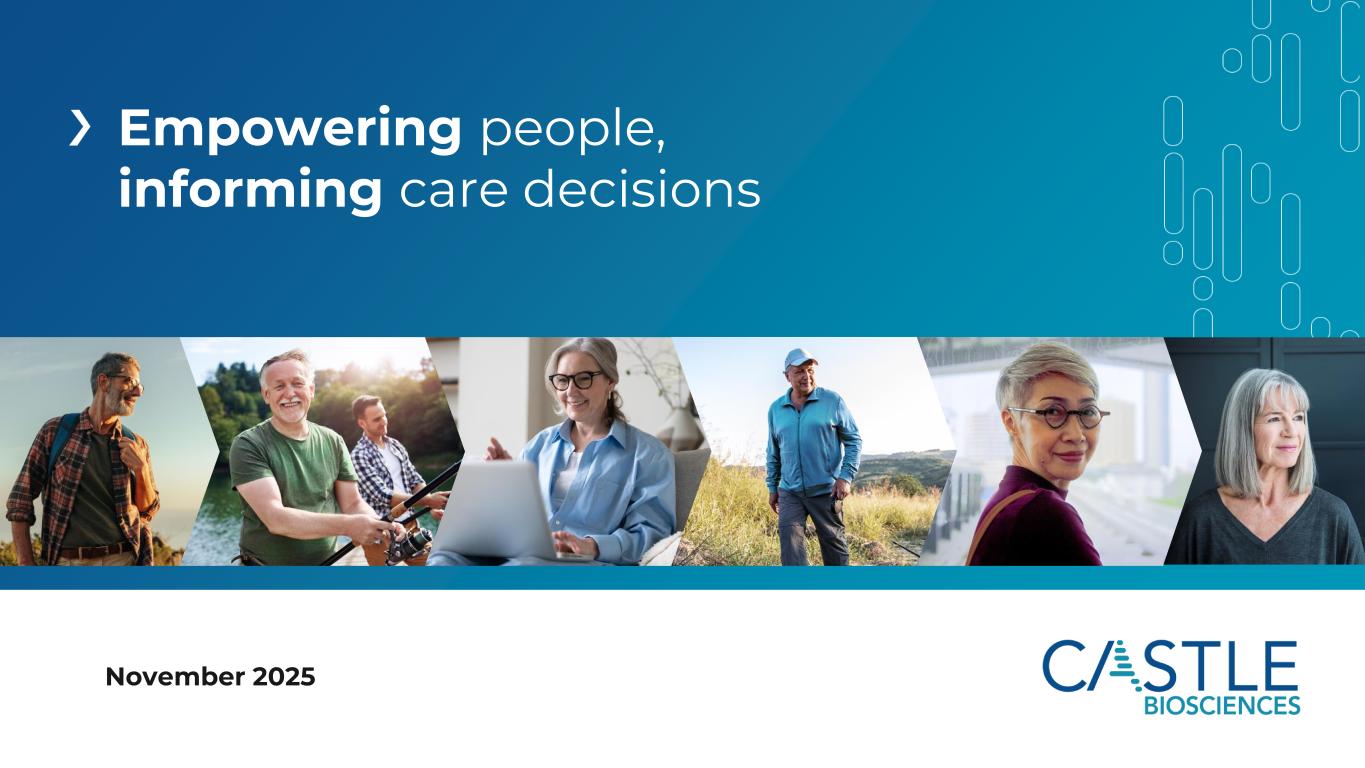
©2025 Castle Biosciences 1 Empowering people, informing care decisions November 2025

©2025 Castle Biosciences 2 Disclaimers Forward-Looking Statements This presentation contains forward-looking statements within the meaning of Section 27A of the Securities Act of 1933, as amended, and Section 21E of the Securities Exchange Act of 1934, as amended, which are subject to the “safe harbor” created by those sections. These forward-looking statements include, but are not limited to, statements concerning: our positioning for continued growth and value creation; our estimated U.S. total addressable market for our commercially available tests; our ongoing studies generating data and their impact on driving adoption of our tests; study observations and interpretations of study data, including conclusions about the benefits and impact of our tests on treatment decisions and patient outcomes; our ability to advance penetration of our tests with clinicians and payers; our ability to carry out our commercial strategies; our ability to be net operating cash flow positive by the end of 2025; our future approach to capital allocation; our expected launch of our pipeline expansion by the end of 2025; the ability to combine spatialomics and DNA methylation for a multiomics approach to patient care; pipeline opportunities to expand screening and diagnostic support for patients with Barrett’s esophagus (BE); test volume growth expectations; and the timing and achievement of program milestones. The words “anticipates,” “can,” “could,” “estimates,” “expects,” “may,” “potential,” “target” and similar expressions are intended to identify forward-looking statements, although not all forward-looking statements contain these identifying words. We may not actually achieve the plans, intentions, or expectations disclosed in our forward-looking statements and you should not place undue reliance on our forward-looking statements. Actual results or events could differ materially from the plans, intentions and expectations disclosed in the forward-looking statements that we make. These forward-looking statements involve risks and uncertainties that could cause our actual results to differ materially from those in the forward- looking statements, including, without limitation: our estimates and assumptions underlying our estimated U.S. total addressable market for our commercially available tests; our assumptions or expectations regarding continued reimbursement for our products and subsequent coverage decisions; Novitas’ local coverage determination signifying non-coverage by Medicare of our DecisionDx-SCC test; our estimated total addressable markets for our products and product candidates; the expenses, capital requirements and potential needs for additional financing, the anticipated cost, timing and success of our product candidates; our plans to research, develop and commercialize new tests; our ability to successfully integrate new businesses, assets, products or technologies acquired through acquisitions; the effects of macroeconomic events and conditions, including inflation and monetary supply shifts, tariffs and disruptions to trade, labor shortages, liquidity concerns at, and failures of, banks and other financial institutions or other disruptions in the banking system or financing markets and recession risks, supply chain disruptions, outbreaks of contagious diseases and geopolitical events (such as the ongoing Israel-Hamas War and Ukraine-Russia conflict), among others, on our business and our efforts to address its impact on our business; the possibility that subsequent study or trial results and findings may contradict earlier study or trial results and findings or may not support the results discussed in this presentation, including with respect to the diagnostic and prognostic tests discussed in this presentation; our planned installation of additional equipment and supporting technology infrastructures and implementation of certain process efficiencies may not enable us to increase the future scalability of our TissueCypher Test; the possibility that actual application of our tests may not provide the anticipated benefits to patients; the possibility that our newer gastroenterology and mental health franchises may not contribute to the achievement of our long-term financial targets as anticipated; and the risks set forth under the heading “Risk Factors” in our Annual Report on Form 10-K for the year ended December 31, 2024, and our Quarterly Report on Form 10-Q for the three months ended September 30, 2025, each filed or to be filed with the SEC, and in our other filings with the SEC. The forward-looking statements are applicable only as of the date on which they are made, and we do not assume any obligation to update any forward-looking statements, except as may be required by law.

©2025 Castle Biosciences 3 Disclaimers Financial Information; Non-GAAP Financial Measures In this presentation, we use the metrics of Adjusted Revenues, Adjusted Gross Margin and Adjusted EBITDA, which are non-GAAP financial measures and are not calculated in accordance with generally accepted accounting principles in the United States (GAAP). Adjusted Revenues and Adjusted Gross Margin reflect adjustments to GAAP net revenues to exclude net positive and/or net negative revenue adjustments recorded in the current period associated with changes in estimated variable consideration related to test reports delivered in previous periods. Adjusted Gross Margin further excludes acquisition-related intangible asset amortization. Adjusted EBITDA excludes from net income (loss): interest income, interest expense, income tax expense (benefit), depreciation and amortization expense, stock-based compensation expense and change in fair value of trading securities. We use Adjusted Revenues, Adjusted Gross Margin and Adjusted EBITDA internally because we believe these metrics provide useful supplemental information in assessing our revenue and operating performance reported in accordance with GAAP, respectively. We believe that Adjusted Revenues, when used in conjunction with our test report volume information, facilitates investors’ analysis of our current-period revenue performance and average selling price performance by excluding the effects of revenue adjustments related to test reports delivered in prior periods, since these adjustments may not be indicative of the current or future performance of our business. We believe that providing Adjusted Revenues may also help facilitate comparisons to our historical periods. Adjusted Gross Margin is calculated using Adjusted Revenues and therefore excludes the impact of revenue adjustments related to test reports delivered in prior periods, which we believe is useful to investors as described above. We further exclude acquisition-related intangible asset amortization in the calculation of Adjusted Gross Margin. We believe that excluding acquisition-related intangible asset amortization may facilitate gross margin comparisons to historical periods and may be useful in assessing current-period performance without regard to the historical accounting valuations of intangible assets, which are applicable only to tests we acquired rather than internally developed. We believe Adjusted EBITDA may enhance an evaluation of our operating performance because it excludes the impact of prior decisions made about capital investment, financing, investing and certain expenses we believe are not indicative of our ongoing performance. However, these non-GAAP financial measures may be different from non-GAAP financial measures used by other companies, even when the same or similarly titled terms are used to identify such measures, limiting their usefulness for comparative purposes. These non-GAAP financial measures are not meant to be considered in isolation or used as substitutes for net revenues, gross margin, or net income (loss) reported in accordance with GAAP; should be considered in conjunction with our financial information presented in accordance with GAAP; have no standardized meaning prescribed by GAAP; are unaudited; and are not prepared under any comprehensive set of accounting rules or principles. In addition, from time to time in the future, there may be other items that we may exclude for purposes of these non- GAAP financial measures, and we may in the future cease to exclude items that we have historically excluded for purposes of these non-GAAP financial measures. Likewise, we may determine to modify the nature of adjustments to arrive at these non-GAAP financial measures. Because of the non-standardized definitions of non-GAAP financial measures, the non-GAAP financial measure as used by us in this press release and the accompanying reconciliation tables have limits in their usefulness to investors and may be calculated differently from, and therefore may not be directly comparable to, similarly titled measures used by other companies. Accordingly, investors should not place undue reliance on non-GAAP financial measures. Reconciliations of these non-GAAP financial measures to the most directly comparable GAAP financial measures are presented in the tables at the end of this presentation. Industry and Market Data This presentation includes certain information and statistics obtained from third-party sources. The Company has not independently verified the accuracy or completeness of any such third- party information.

©2025 Castle Biosciences 4 Registered Trademarks DecisionDx-Melanoma, DecisionDx-CMSeq, i31-SLNB, i31-ROR, DecisionDx-SCC, MyPath Melanoma, AdvanceAD-Tx, TissueCypher, DecisionDx-UM, DecisionDx-PRAME and DecisionDx-UMSeq are trademarks of Castle Biosciences, Inc.

©2025 Castle Biosciences 5 Improving health through innovative tests that guide patient care OUR MISSION Transforming disease management by keeping people first: patients, clinicians, employees, and investors OUR VISION

©2025 Castle Biosciences 6 Key Q3 2025 and recent results 1 Gross Margin for Q325 was 75%, and Adjusted Gross Margin was 77%, compared to 79% and 82% respectively for the same periods in 2024 5 Net cash provided by operations in Q325 was $22.6 million, compared to $23.3 million net cash provided by operations in Q324 Q325 total test reports for our core revenue drivers (DecisionDx- Melanoma, TissueCypher) increased 36% over Q324 As of September 30, 2025, cash, cash equivalents and marketable investment securities totaled $287.5 million 6 Net loss for Q325 was $0.5 million and Adjusted EBITDA for Q325 was $9.2 million Announced launch of AdvanceAD-Tx , the Company’s test designed to guide systemic therapy decision making in patients ages 12 and older with moderate-to-severe atopic dermatitis (AD) 2 3 Adjusted Gross Margin and Adjusted EBITDA are non-GAAP measures. See non-GAAP reconciliations at the end of this presentation for a reconciliation of Adjusted Gross Margin and Adjusted EBITDA to their most closely comparabl GAAP measures. 4 1
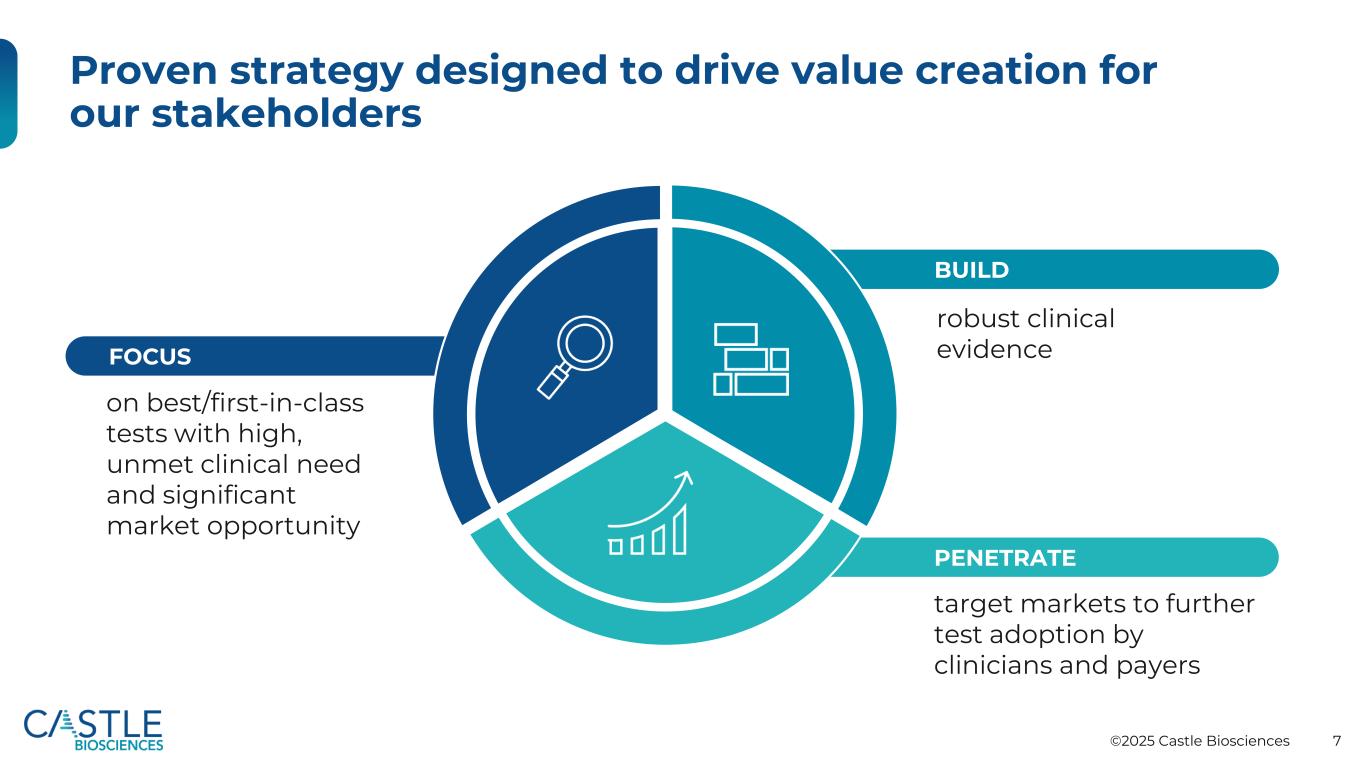
©2025 Castle Biosciences 7 Proven strategy designed to drive value creation for our stakeholders FOCUS on best/first-in-class tests with high, unmet clinical need and significant market opportunity BUILD robust clinical evidence PENETRATE target markets to further test adoption by clinicians and payers
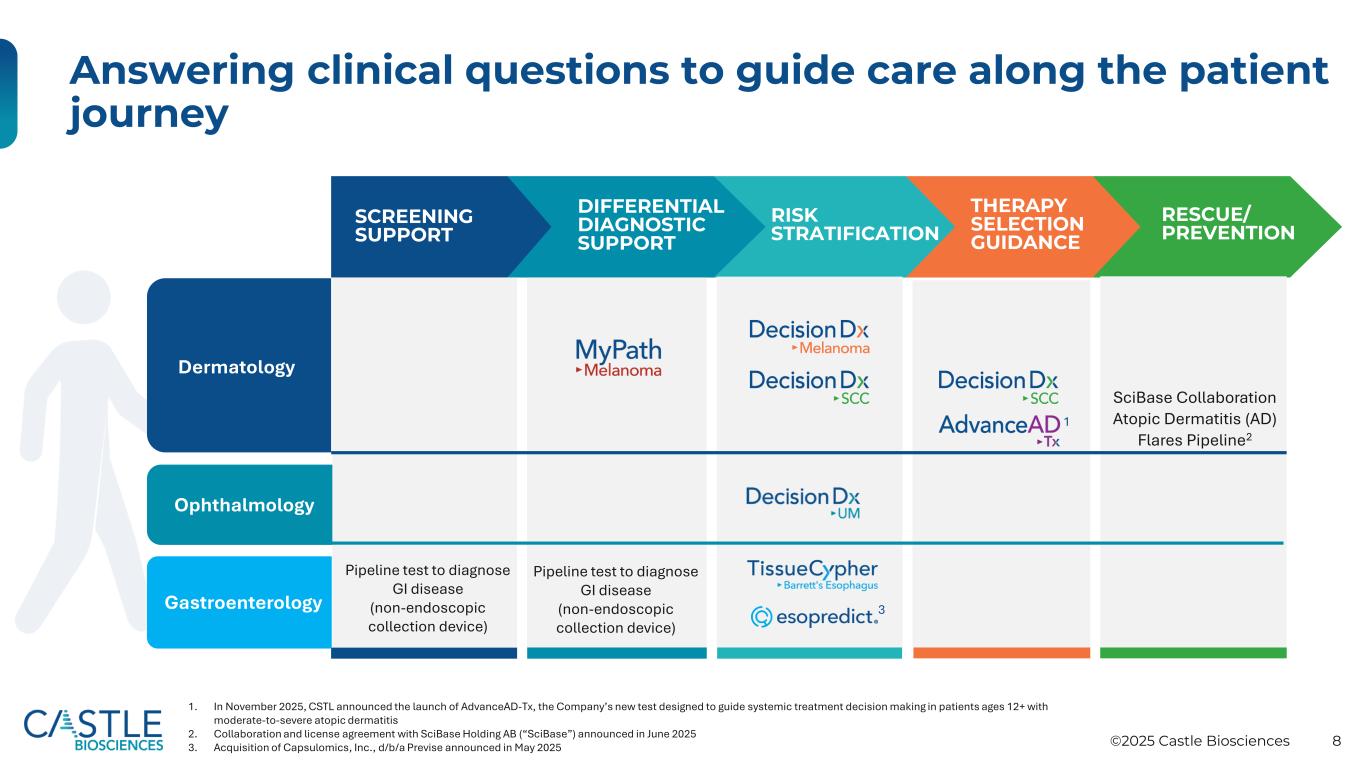
©2025 Castle Biosciences 8 Answering clinical questions to guide care along the patient journey 1. In November 2025, CSTL announced the launch of AdvanceAD-Tx, the Company’s new test designed to guide systemic treatment decision making in patients ages 12+ with moderate-to-severe atopic dermatitis 2. Collaboration and license agreement with SciBase Holding AB (“SciBase”) announced in June 2025 3. Acquisition of Capsulomics, Inc., d/b/a Previse announced in May 2025 RESCUE/ PREVENTION DIFFERENTIAL DIAGNOSTIC SUPPORT RISK STRATIFICATION THERAPY SELECTION GUIDANCE MRD=minimal residual disease SCREENING SUPPORT Dermatology Ophthalmology Gastroenterology Pipeline test to diagnose GI disease (non-endoscopic collection device) Pipeline test to diagnose GI disease (non-endoscopic collection device) 1 SciBase Collaboration Atopic Dermatitis (AD) Flares Pipeline2 3
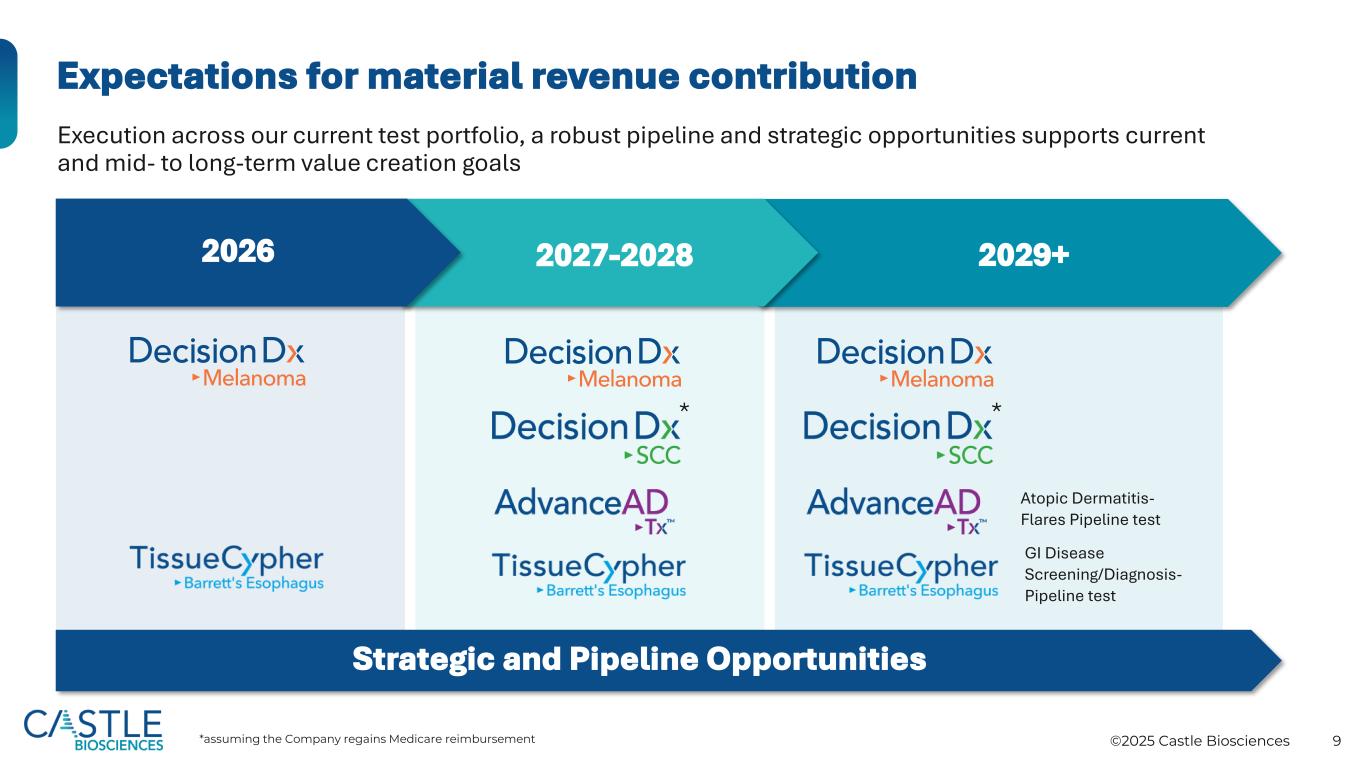
©2025 Castle Biosciences 9 Expectations for material revenue contribution Atopic Dermatitis- Flares Pipeline test Execution across our current test portfolio, a robust pipeline and strategic opportunities supports current and mid- to long-term value creation goals GI Disease Screening/Diagnosis- Pipeline test *assuming the Company regains Medicare reimbursement * 2026 2027-2028 2029+ * Strategic and Pipeline Opportunities
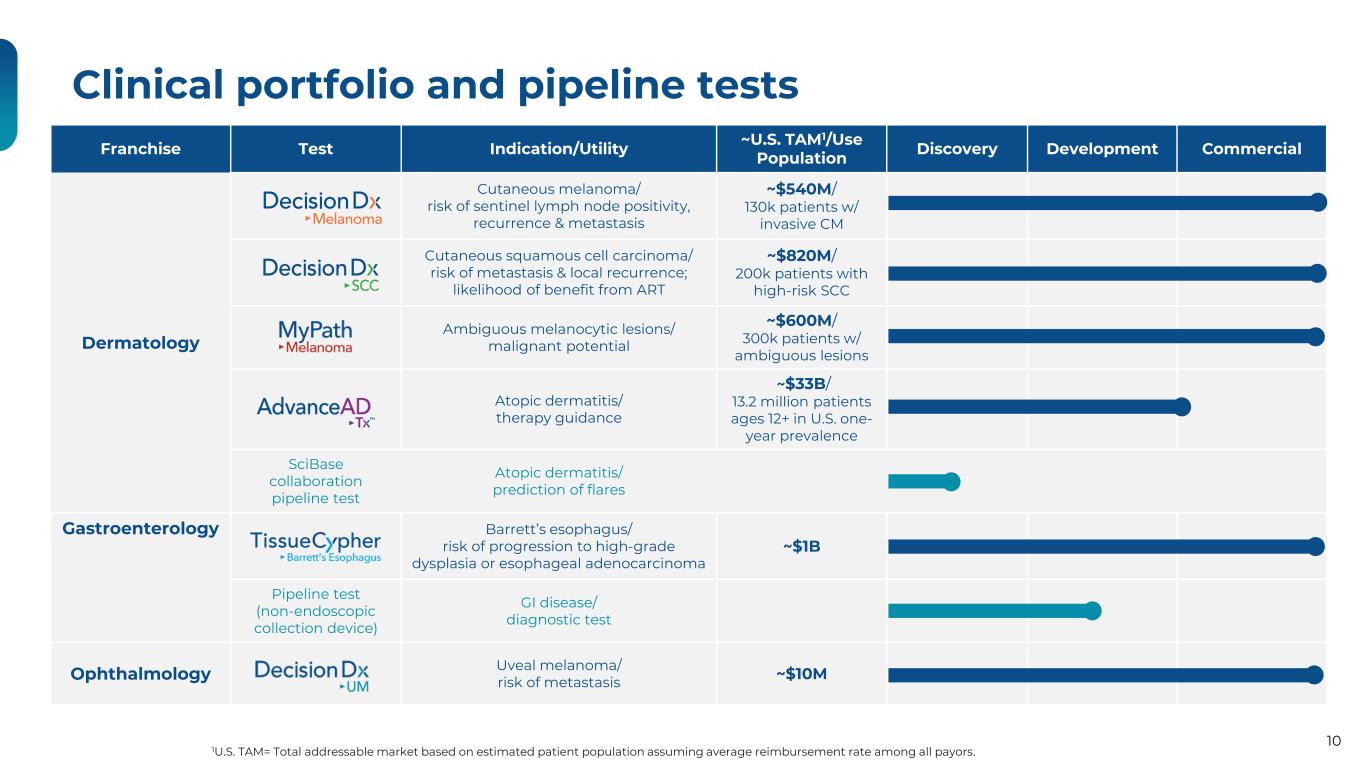
©2025 Castle Biosciences 10 Clinical portfolio and pipeline tests Franchise Test Indication/Utility ~U.S. TAM1/Use Population Discovery Development Commercial Dermatology Cutaneous melanoma/ risk of sentinel lymph node positivity, recurrence & metastasis ~$540M/ 130k patients w/ invasive CM Cutaneous squamous cell carcinoma/ risk of metastasis & local recurrence; likelihood of benefit from ART ~$820M/ 200k patients with high-risk SCC Ambiguous melanocytic lesions/ malignant potential ~$600M/ 300k patients w/ ambiguous lesions Atopic dermatitis/ therapy guidance ~$33B/ 13.2 million patients ages 12+ in U.S. one- year prevalence SciBase collaboration pipeline test Atopic dermatitis/ prediction of flares Gastroenterology Barrett’s esophagus/ risk of progression to high-grade dysplasia or esophageal adenocarcinoma ~$1B Pipeline test (non-endoscopic collection device) GI disease/ diagnostic test Ophthalmology Uveal melanoma/ risk of metastasis ~$10M 1U.S. TAM= Total addressable market based on estimated patient population assuming average reimbursement rate among all payors.
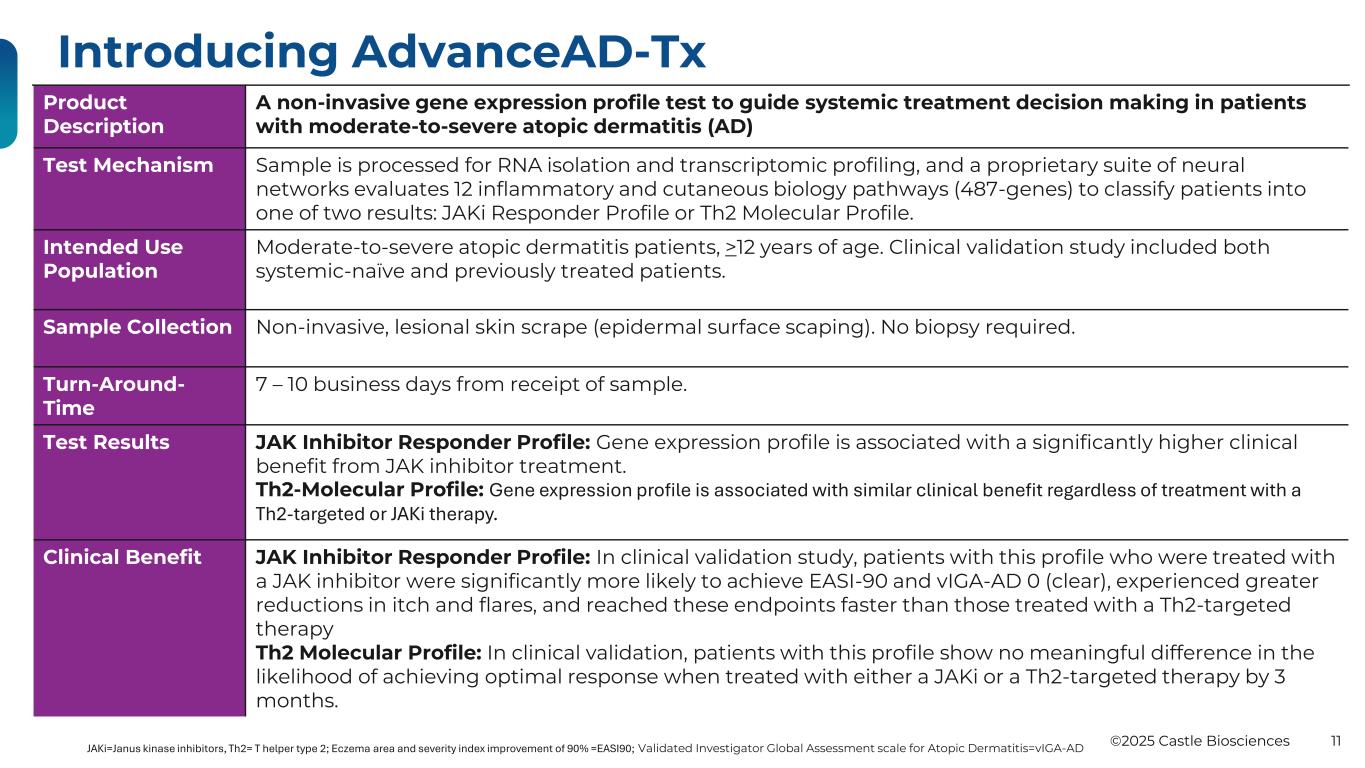
©2025 Castle Biosciences 11 Introducing AdvanceAD-Tx Product Description A non-invasive gene expression profile test to guide systemic treatment decision making in patients with moderate-to-severe atopic dermatitis (AD) Test Mechanism Sample is processed for RNA isolation and transcriptomic profiling, and a proprietary suite of neural networks evaluates 12 inflammatory and cutaneous biology pathways (487-genes) to classify patients into one of two results: JAKi Responder Profile or Th2 Molecular Profile. Intended Use Population Moderate-to-severe atopic dermatitis patients, >12 years of age. Clinical validation study included both systemic-naïve and previously treated patients. Sample Collection Non-invasive, lesional skin scrape (epidermal surface scaping). No biopsy required. Turn-Around- Time 7 – 10 business days from receipt of sample. Test Results JAK Inhibitor Responder Profile: Gene expression profile is associated with a significantly higher clinical benefit from JAK inhibitor treatment. Th2-Molecular Profile: Gene expression profile is associated with similar clinical benefit regardless of treatment with a Th2-targeted or JAKi therapy. Clinical Benefit JAK Inhibitor Responder Profile: In clinical validation study, patients with this profile who were treated with a JAK inhibitor were significantly more likely to achieve EASI-90 and vIGA-AD 0 (clear), experienced greater reductions in itch and flares, and reached these endpoints faster than those treated with a Th2-targeted therapy Th2 Molecular Profile: In clinical validation, patients with this profile show no meaningful difference in the likelihood of achieving optimal response when treated with either a JAKi or a Th2-targeted therapy by 3 months. JAKi=Janus kinase inhibitors, Th2= T helper type 2; Eczema area and severity index improvement of 90% =EASI90; Validated Investigator Global Assessment scale for Atopic Dermatitis=vIGA-AD
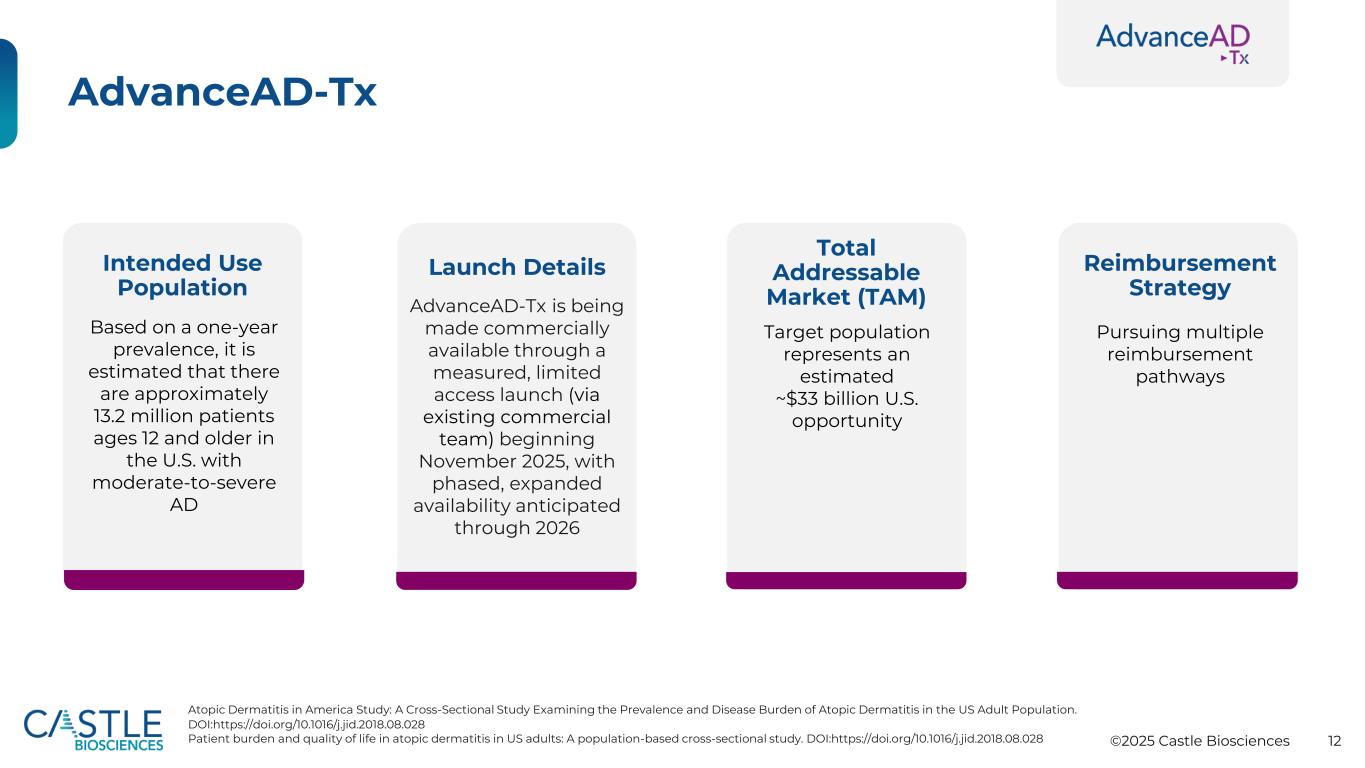
©2025 Castle Biosciences 12 Based on a one-year prevalence, it is estimated that there are approximately 13.2 million patients ages 12 and older in the U.S. with moderate-to-severe AD Intended Use Population AdvanceAD-Tx is being made commercially available through a measured, limited access launch (via existing commercial team) beginning November 2025, with phased, expanded availability anticipated through 2026 Launch Details Pursuing multiple reimbursement pathways Reimbursement Strategy Target population represents an estimated ~$33 billion U.S. opportunity Total Addressable Market (TAM) AdvanceAD-Tx Atopic Dermatitis in America Study: A Cross-Sectional Study Examining the Prevalence and Disease Burden of Atopic Dermatitis in the US Adult Population. DOI:https://doi.org/10.1016/j.jid.2018.08.028 Patient burden and quality of life in atopic dermatitis in US adults: A population-based cross-sectional study. DOI:https://doi.org/10.1016/j.jid.2018.08.028

©2025 Castle Biosciences 13 Data from the IDENTITY Study Patients with JAKi Responder Profile who are treated with a JAK inhibitor therapy, compared to those treated with a Th2- targeted therapy achieve the following by 3 months: Achieved a higher rate of EASI-90 (45.5% vs 8.3%, p=0.021) More likely to report “no itch” by three months (45.5% vs. 8.3%, p=0.021) More likely to remain flare-free during treatment (54.5% vs. 16.7%, p=0.041) Reached EASI-90 3.8 times faster (p=0.049) More likely to achieve a validated investigator global assessment score of clear (vIGA-AD 0, 36.4% vs 0%, p=0.006) Adapted from Silverberg J, et al. The 487-gene expression profile test guides systemic therapy selection to improve outcomes for patients with atopic dermatitis: Results from a prospective, multi-center trial. Fall Clinical Dermatology Conference. 10.3.2025 Eczema area and severity index improvement of 90% =EASI90.

©2025 Castle Biosciences 14 Individual risk of SLNB positivity Individual risk of recurrence ? 31-GEP Class Score Ulceration Breslow thickness Age Mitotic rate Ulceration Age Breslow thickness Mitotic rate SLN status Tumor location Collaborative study with the National Cancer Institute’s SEER Program Registries is the largest real- world study of GEP testing in melanoma (n=4,687): • SEER cohort of unselected, prospectively tested patients shows improved survival for patients tested with DecisionDx-Melanoma compared to untested patients with 29% lower 3-year melanoma-specific and 17% lower 3-year overall mortality, and • DecisionDx-Melanoma provided significant, independent risk stratification of patients with cutaneous melanoma SLN- patients with a high-risk DecisionDx-Melanoma result had routine imaging surveillance added to their treatment plan. These patients: • Had their recurrence detected ~10 months earlier, with 62% lower tumor burden • Were more likely to start immunotherapy when offered (76.3% vs 67.9%) • Saw improved overall survival outcomes at 45 months (86.8% vs 75%) Whitman et al. JCO PO. 2021; Jarell et al. JAAD. 2022 Bailey et al. 2023; Dhillon et al. 2023 BUILD “Patients who received routine imaging after high- risk GEP test scores had an earlier recurrence diagnosis with lower tumor burden, leading to better clinical outcomes.” Clinical use of DecisionDx-Melanoma is associated with improved patient survival DecisionDx-Melanoma provides precise, personalized risk prediction for two critical clinical questions
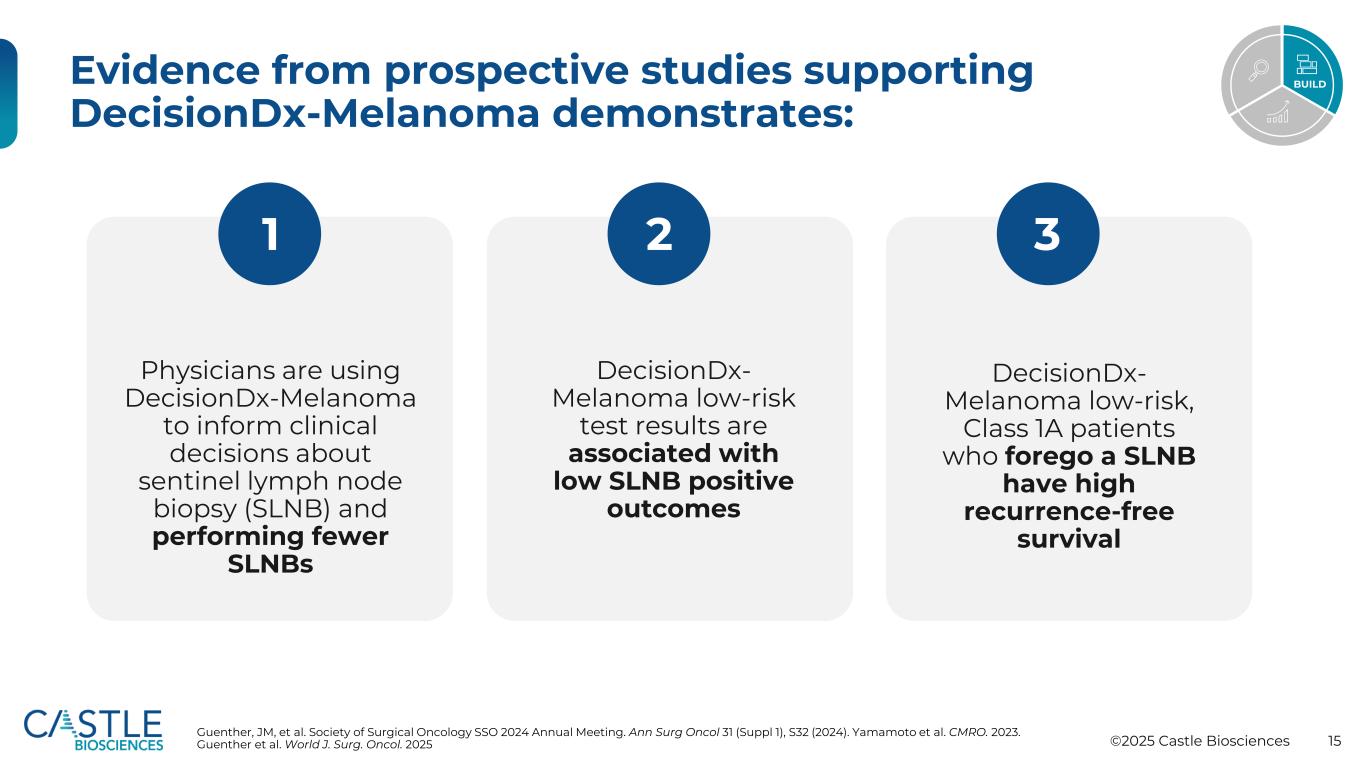
©2025 Castle Biosciences 15 Evidence from prospective studies supporting DecisionDx-Melanoma demonstrates: DecisionDx- Melanoma low-risk, Class 1A patients who forego a SLNB have high recurrence-free survival DecisionDx- Melanoma low-risk test results are associated with low SLNB positive outcomes Physicians are using DecisionDx-Melanoma to inform clinical decisions about sentinel lymph node biopsy (SLNB) and performing fewer SLNBs Guenther, JM, et al. Society of Surgical Oncology SSO 2024 Annual Meeting. Ann Surg Oncol 31 (Suppl 1), S32 (2024). Yamamoto et al. CMRO. 2023. Guenther et al. World J. Surg. Oncol. 2025 1 2 3 BUILD
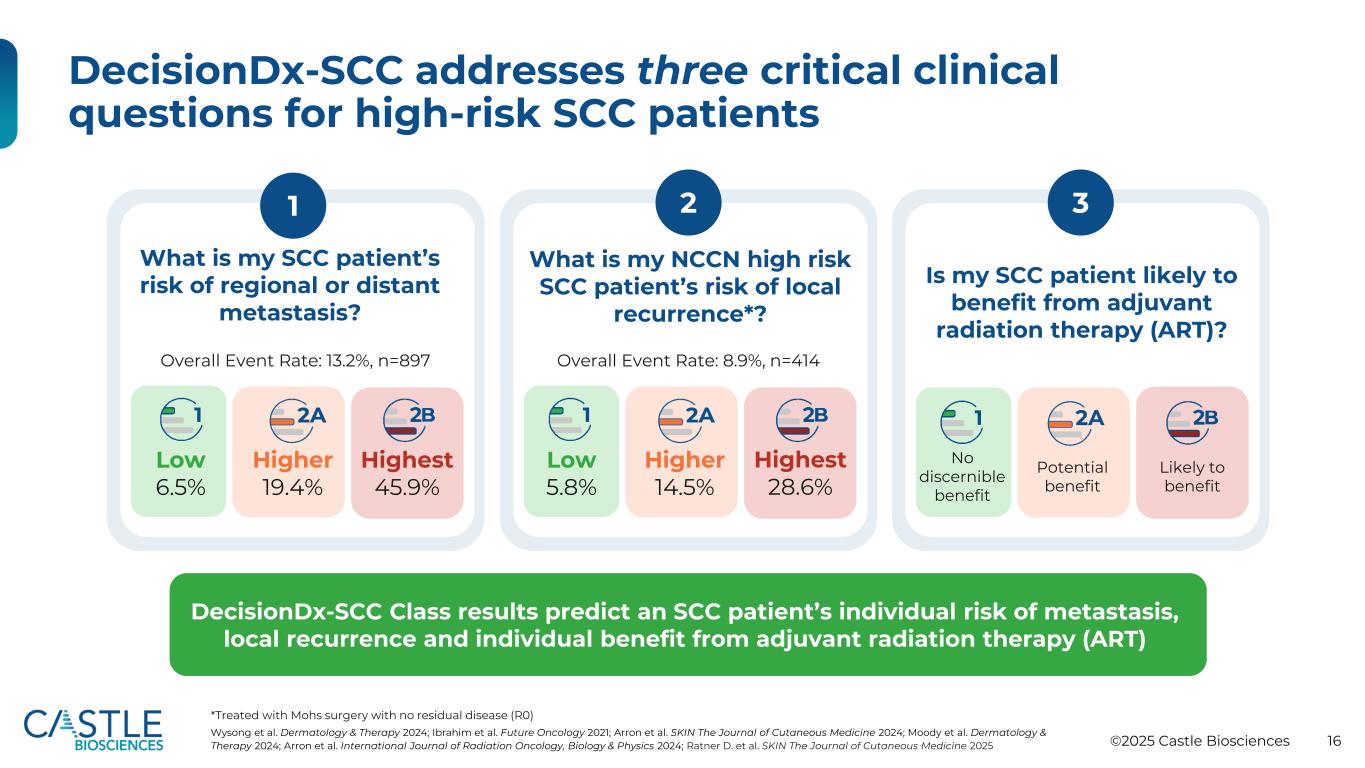
©2025 Castle Biosciences 16 DecisionDx-SCC addresses three critical clinical questions for high-risk SCC patients Wysong et al. Dermatology & Therapy 2024; Ibrahim et al. Future Oncology 2021; Arron et al. SKIN The Journal of Cutaneous Medicine 2024; Moody et al. Dermatology & Therapy 2024; Arron et al. International Journal of Radiation Oncology, Biology & Physics 2024; Ratner D. et al. SKIN The Journal of Cutaneous Medicine 2025 DecisionDx-SCC Class results predict an SCC patient’s individual risk of metastasis, local recurrence and individual benefit from adjuvant radiation therapy (ART) *Treated with Mohs surgery with no residual disease (R0) Overall Event Rate: 13.2%, n=897 1 What is my SCC patient’s risk of regional or distant metastasis? Low 6.5% Higher 19.4% Highest 45.9% Overall Event Rate: 8.9%, n=414 2 What is my NCCN high risk SCC patient’s risk of local recurrence*? Low 5.8% Higher 14.5% Highest 28.6% 3 Is my SCC patient likely to benefit from adjuvant radiation therapy (ART)? No discernible benefit Potential benefit Likely to benefit
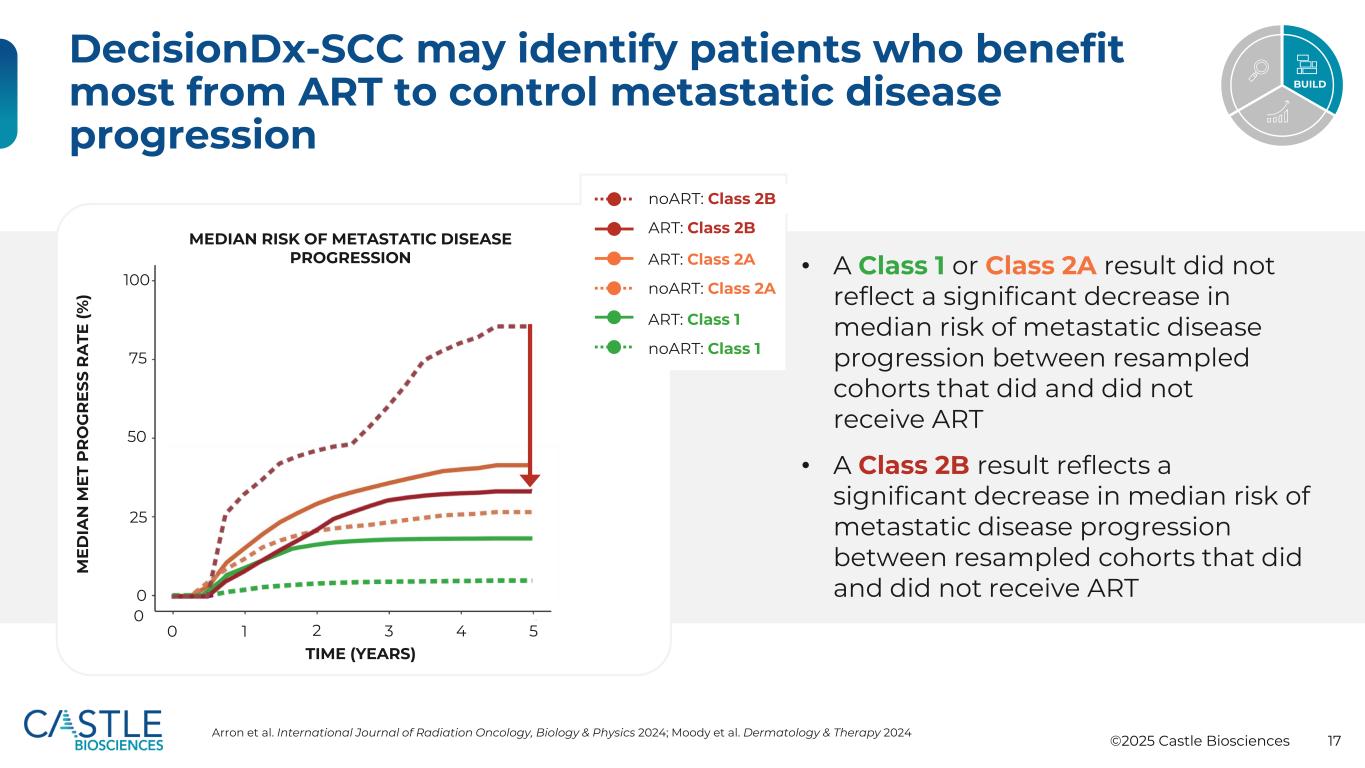
©2025 Castle Biosciences 17 DecisionDx-SCC may identify patients who benefit most from ART to control metastatic disease progression Arron et al. International Journal of Radiation Oncology, Biology & Physics 2024; Moody et al. Dermatology & Therapy 2024 • A Class 2B result reflects a significant decrease in median risk of metastatic disease progression between resampled cohorts that did and did not receive ART M E D IA N M E T P R O G R E S S R A T E ( % ) TIME (YEARS) 1.00 0.75 0.50 0.25 0.0 0 0 1 2 3 4 5 MEDIAN RISK OF METASTATIC DISEASE PROGRESSION ART: Class 1 noART: Class 1 noART: Class 2A ART: Class 2A ART: Class 2B noART: Class 2B • A Class 1 or Class 2A result did not reflect a significant decrease in median risk of metastatic disease progression between resampled cohorts that did and did not receive ART 100 5 5 BUILD

©2025 Castle Biosciences 18 TissueCypher provides individualized 5-year risk of progression to HGD or EAC Low RiskHigh Risk • High Risk score enables increased surveillance or early intervention to prevent cancer1 • Low Risk score minimizes over-treatment and supports extension of surveillance intervals to guideline recommendations Indicated for NDBE, IND, and LGD 1. Rubenstein JH, et al. Gastroenterology. 2024.
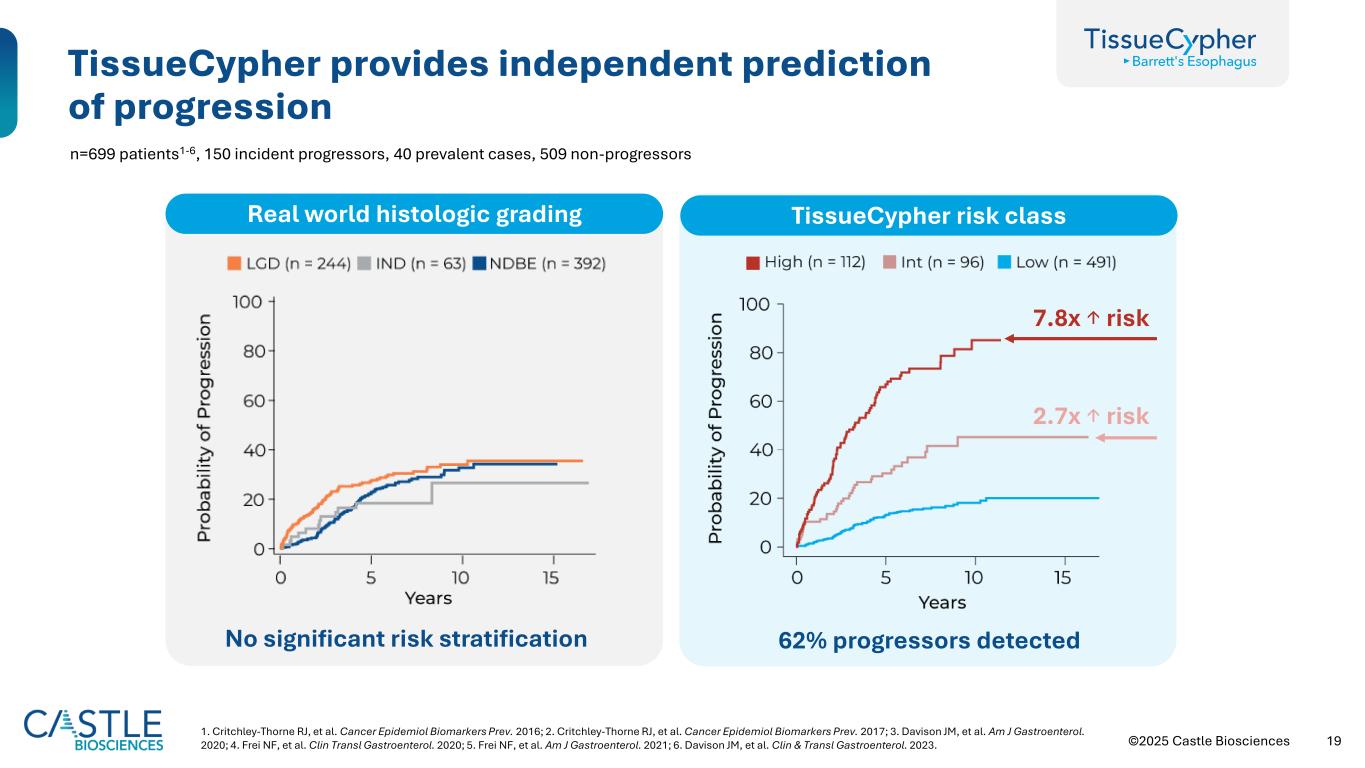
©2025 Castle Biosciences 19 TissueCypher provides independent prediction of progression n=699 patients1-6, 150 incident progressors, 40 prevalent cases, 509 non-progressors No significant risk stratification 62% progressors detected 7.8x ↑ risk 2.7x ↑ risk 1. Critchley-Thorne RJ, et al. Cancer Epidemiol Biomarkers Prev. 2016; 2. Critchley-Thorne RJ, et al. Cancer Epidemiol Biomarkers Prev. 2017; 3. Davison JM, et al. Am J Gastroenterol. 2020; 4. Frei NF, et al. Clin Transl Gastroenterol. 2020; 5. Frei NF, et al. Am J Gastroenterol. 2021; 6. Davison JM, et al. Clin & Transl Gastroenterol. 2023. Real world histologic grading TissueCypher risk class

©2025 Castle Biosciences 20 Financials

©2025 Castle Biosciences 21 Well positioned for continued value creation Drive robust test volume growth Maintain strong Adjusted Gross Margin Goal to achieve operating cash flow positivity by the end of 2025 Maintain strong balance sheet Follow disciplined capital allocation

©2025 Castle Biosciences 22 Strong test volume growth in our core revenue drivers NET REVENUE BY TYPE ($M) TOTAL TEST VOLUME FOR CORE REVENUE DRIVERS3 1. Consists of DecisionDx-Melanoma, DecisionDx-SCC and our Diagnostic Gene Expression Profile offering 2. Consists of TissueCypher, DecisionDx-UM and IDgenetix 3. Core revenue drivers consists of DecisionDx-Melanoma and TissueCypher $48.5 $34.5 Dermatologic Non-Dermatologic 1 2 Q3 2025 10,45910,609 DecisionDx-Melanoma TissueCypher Q3 2025 Q3 2025 total test reports for our core revenue drivers (DecisionDx- Melanoma, TissueCypher) increased 36% over Q3 2024 Q3 2025 Non- Dermatologic revenue increased by 67% over Q3 2024
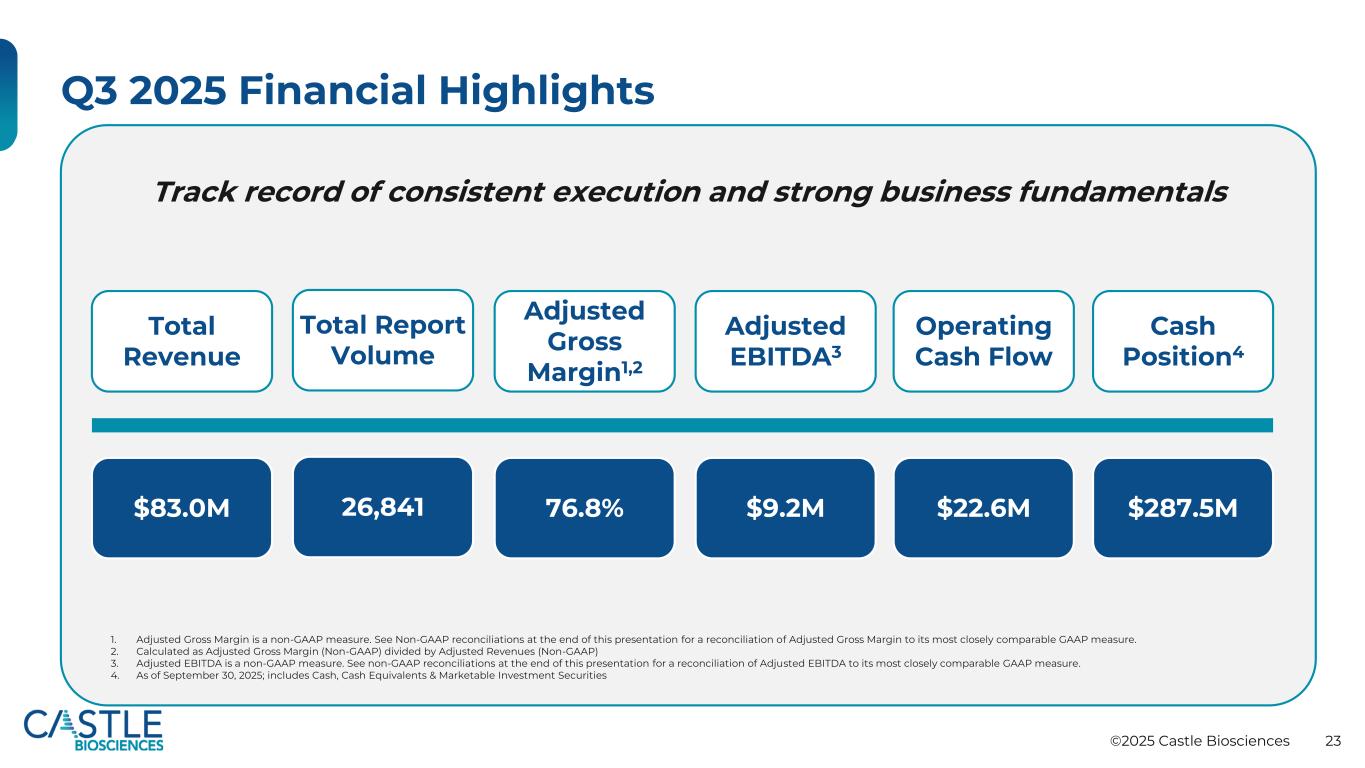
©2025 Castle Biosciences 23 Q3 2025 Financial Highlights Total Revenue Cash Position4 Operating Cash Flow Total Report Volume Adjusted Gross Margin1,2 Adjusted EBITDA3 $83.0M $287.5M$22.6M26,841 76.8% $9.2M 1. Adjusted Gross Margin is a non-GAAP measure. See Non-GAAP reconciliations at the end of this presentation for a reconciliation of Adjusted Gross Margin to its most closely comparable GAAP measure. 2. Calculated as Adjusted Gross Margin (Non-GAAP) divided by Adjusted Revenues (Non-GAAP) 3. Adjusted EBITDA is a non-GAAP measure. See non-GAAP reconciliations at the end of this presentation for a reconciliation of Adjusted EBITDA to its most closely comparable GAAP measure. 4. As of September 30, 2025; includes Cash, Cash Equivalents & Marketable Investment Securities Track record of consistent execution and strong business fundamentals

©2025 Castle Biosciences 24 A disciplined approach to capital allocation Commercial optimization Focused R&D efforts to build evidentiary support and develop tests As a lesser priority, strategic opportunities, including within our current therapeutic areas

©2025 Castle Biosciences 25 Appendix
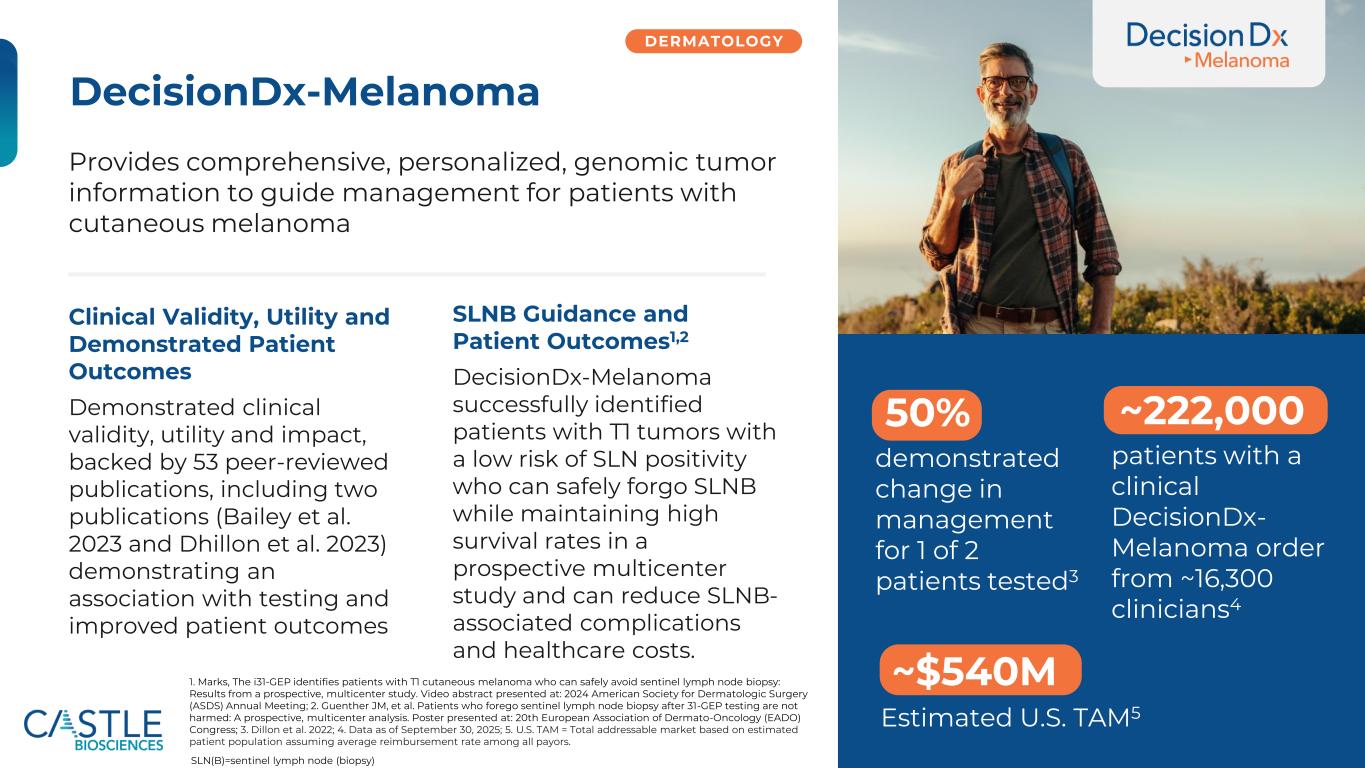
©2025 Castle Biosciences 26 DecisionDx-Melanoma DERMATOLOGY Provides comprehensive, personalized, genomic tumor information to guide management for patients with cutaneous melanoma demonstrated change in management for 1 of 2 patients tested3 ~222,000 patients with a clinical DecisionDx- Melanoma order from ~16,300 clinicians4 50% Clinical Validity, Utility and Demonstrated Patient Outcomes Demonstrated clinical validity, utility and impact, backed by 53 peer-reviewed publications, including two publications (Bailey et al. 2023 and Dhillon et al. 2023) demonstrating an association with testing and improved patient outcomes SLNB Guidance and Patient Outcomes1,2 DecisionDx-Melanoma successfully identified patients with T1 tumors with a low risk of SLN positivity who can safely forgo SLNB while maintaining high survival rates in a prospective multicenter study and can reduce SLNB- associated complications and healthcare costs. 1. Marks, The i31-GEP identifies patients with T1 cutaneous melanoma who can safely avoid sentinel lymph node biopsy: Results from a prospective, multicenter study. Video abstract presented at: 2024 American Society for Dermatologic Surgery (ASDS) Annual Meeting; 2. Guenther JM, et al. Patients who forego sentinel lymph node biopsy after 31-GEP testing are not harmed: A prospective, multicenter analysis. Poster presented at: 20th European Association of Dermato-Oncology (EADO) Congress; 3. Dillon et al. 2022; 4. Data as of September 30, 2025; 5. U.S. TAM = Total addressable market based on estimated patient population assuming average reimbursement rate among all payors. SLN(B)=sentinel lymph node (biopsy) ~$540M Estimated U.S. TAM5
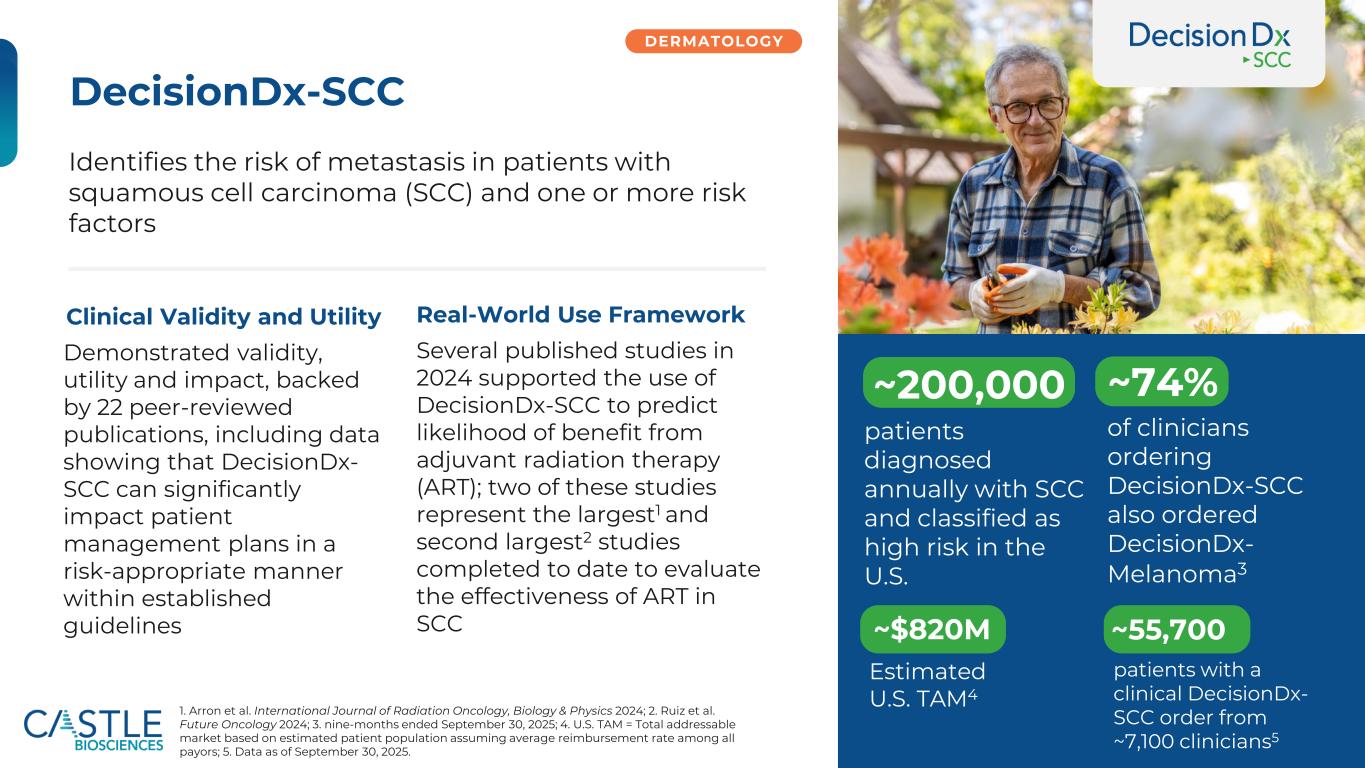
©2025 Castle Biosciences 27 DecisionDx-SCC DERMATOLOGY Identifies the risk of metastasis in patients with squamous cell carcinoma (SCC) and one or more risk factors Clinical Validity and Utility Demonstrated validity, utility and impact, backed by 22 peer-reviewed publications, including data showing that DecisionDx- SCC can significantly impact patient management plans in a risk-appropriate manner within established guidelines Real-World Use Framework Several published studies in 2024 supported the use of DecisionDx-SCC to predict likelihood of benefit from adjuvant radiation therapy (ART); two of these studies represent the largest1 and second largest2 studies completed to date to evaluate the effectiveness of ART in SCC Estimated U.S. TAM4 ~200,000 ~74% ~$820M patients diagnosed annually with SCC and classified as high risk in the U.S. of clinicians ordering DecisionDx-SCC also ordered DecisionDx- Melanoma3 1. Arron et al. International Journal of Radiation Oncology, Biology & Physics 2024; 2. Ruiz et al. Future Oncology 2024; 3. nine-months ended September 30, 2025; 4. U.S. TAM = Total addressable market based on estimated patient population assuming average reimbursement rate among all payors; 5. Data as of September 30, 2025. patients with a clinical DecisionDx- SCC order from ~7,100 clinicians5 ~55,700

©2025 Castle Biosciences 28 MyPath Melanoma DERMATOLOGY Aids in the diagnosis and management for patients with ambiguous melanocytic lesions Clinical Validity and Utility Demonstrated validity, utility and impact, backed by 20 peer-reviewed publications demonstrating the performance and utility of the test in providing objective information to aid in diagnosis in ambiguous melanocytic lesions Guideline Support • National Comprehensive Cancer Network guidelines for cutaneous melanoma in the principles for molecular testing • American Society of Dermatopathology in the Appropriate Use Criteria for ancillary diagnostic testing • American Academy of Dermatology guidelines of care for the management of primary cutaneous melanoma Estimated U.S. TAM2 ~300,000 patients each year present with a diagnostically ambiguous lesion 50,000+ lesions tested clinically1 ~$600M 1. As of September 30, 2025; 2. U.S. TAM = Total addressable market based on estimated patient population assuming average reimbursement rate among all payors.

©2025 Castle Biosciences 29 AdvanceAD-Tx DERMATOLOGY A non-invasive molecular test that is designed to detect the underlying immune biology of atopic dermatitis (AD) that is driving an individual patient’s AD and thus helps to guide systemic treatment decision making in patients with moderate- to-severe AD Validated in Real-World Patients • The AdvanceAD-Tx test has been clinically validated in patients 12 years and older with moderate-to-severe AD. The clinical validation study included both systemic treatment naïve patients and those who were on a systemic treatment but considering a switch in therapy. • The test can be ordered at any point in the patient’s treatment journey and provides valuable molecular insight to help guide therapy-class selection. Ordering the test early may help reduce uncertainty, minimize trial-and-error, and support more timely disease control. ~13.2m patient population of moderate-to- severe AD patients 12+ year of age, based on one-year prevalance1 ~$33 billion 1. Atopic Dermatitis in America Study: A Cross-Sectional Study Examining the Prevalence and Disease Burden of Atopic Dermatitis in the US Adult Population. DOI:https://doi.org/10.1016/j.jid.2018.08.028. Patient burden and quality of life in atopic dermatitis in US adults: A population-based cross-sectional study. DOI:https://doi.org/10.1016/j.jid.2018.08.028 2. https://pmc.ncbi.nlm.nih.gov/articles/PMC11904833/pdf/ActaDV-105-41504.pdf; 3. U.S. TAM = Total addressable market based on estimated patient population assuming average reimbursement rate among all payors. of patients who started on an advanced biologic or JAKi switched to another advanced systemic therapy2 ~27% Estimated U.S. TAM3

©2025 Castle Biosciences 30 TissueCypher GASTROENTEROLOGY A leading risk-stratification test designed to predict risk of progression to esophageal cancer in patients with Barrett’s esophagus Clinical Validity and Utility Demonstrated validity, utility and impact, backed by 16 peer-reviewed publications demonstrating the ability and performance of the test in risk-stratifying patients with Barrett’s esophagus to guide risk- appropriate treatment decisions Recognition from AGA 2024 Clinical Practice Guideline acknowledges that individuals who may be at increased risk of progression to esophageal cancer might be identified using tissue-based biomarkers, particularly TissueCypher 2022 Recognized in the Clinical Practice Update on New Technology and Innovation for Surveillance and Screening in Barrett’s Esophagus as a tool that may be used by physicians to risk stratify non-dysplastic patients ~415,000 patients receiving upper GI endoscopies per year who meet intended use criteria for TissueCypher 1 in 40 patients progress to esophageal cancer within 5 years (among BE patients)1 ~$1B 1. Shaheen et al. Gastroenterology 2000; 2. U.S. TAM = Total addressable market based on estimated patient population assuming average reimbursement rate among all payors. Estimated U.S. TAM2
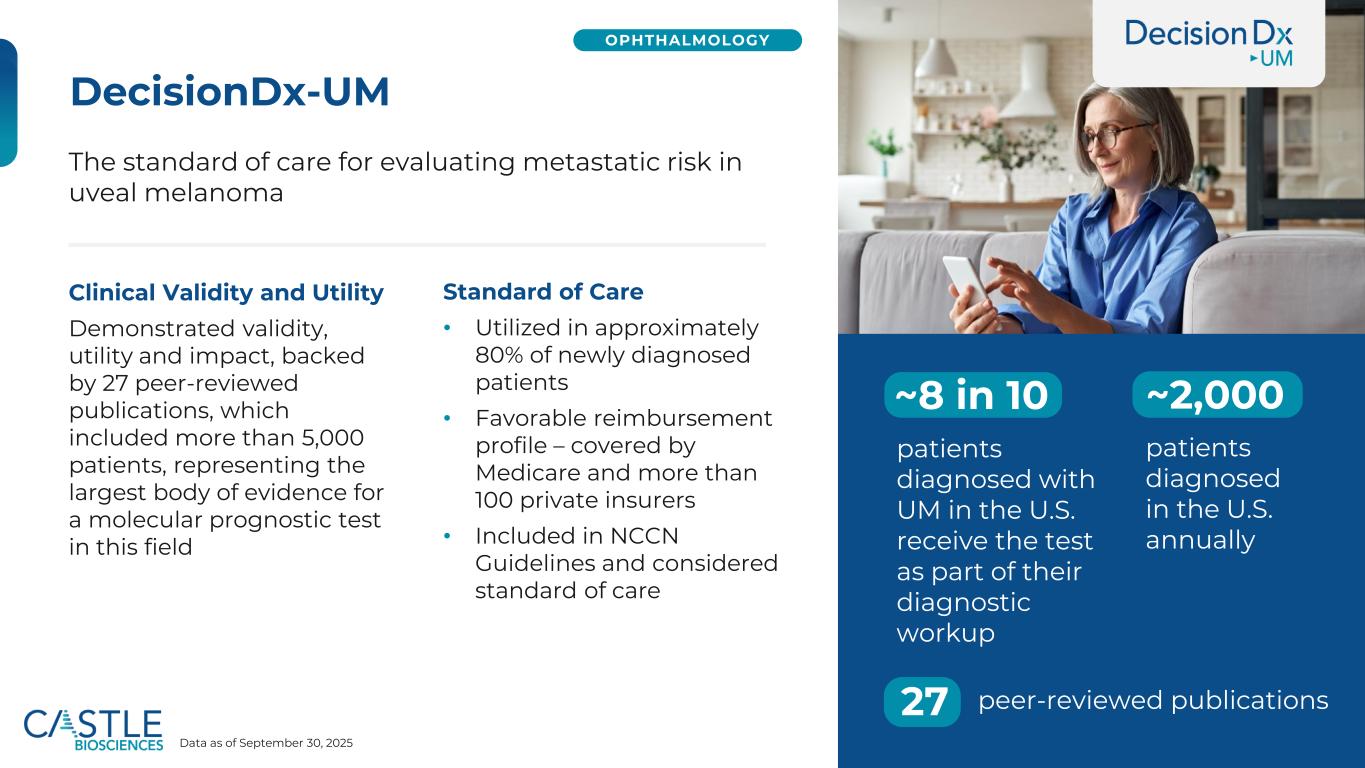
©2025 Castle Biosciences 31 DecisionDx-UM OPHTHALMOLOGY The standard of care for evaluating metastatic risk in uveal melanoma Standard of Care • Utilized in approximately 80% of newly diagnosed patients • Favorable reimbursement profile – covered by Medicare and more than 100 private insurers • Included in NCCN Guidelines and considered standard of care peer-reviewed publications ~8 in 10 ~2,000 27 patients diagnosed in the U.S. annually patients diagnosed with UM in the U.S. receive the test as part of their diagnostic workup Clinical Validity and Utility Demonstrated validity, utility and impact, backed by 27 peer-reviewed publications, which included more than 5,000 patients, representing the largest body of evidence for a molecular prognostic test in this field Data as of September 30, 2025

©2025 Castle Biosciences 32 Reconciliation of Non-GAAP Financial Measures (Unaudited) The table below presents the reconciliation of Adjusted Revenues and Adjusted Gross Margin, which are non-GAAP financial measures. See "Use of Non- GAAP Financial Measures (UNAUDITED)" above for further information regarding the Company's use of non-GAAP financial measures. (In thousands) Three months ended Sep. 30, 2025 Jun. 30, 2025 Mar. 31, 2025 Dec. 31, 2024 Sep. 30, 2024 Adjusted Revenues Net revenues (GAAP) $83,043 $86,188 $87,988 $86,311 $85,782 Revenue associated with test reports delivered in prior periods (2,498) (6) (787) (491) 552 Adjusted Revenues (Non-GAAP) $80,545 $86,182 $87,201 $85,820 $86,334 Adjusted Gross Margin Gross margin (GAAP)1 $62,063 $66,601 $43,280 $65,788 $67,901 Amortization of acquired intangible assets 2,276 1,961 28,325 4,340 2,272 Revenue associated with test reports delivered in prior periods (2,498) (6) (787) (491) 552 Adjusted Gross Margin (Non-GAAP) $61,841 $68,556 $70,818 $69,637 $70,725 Gross Margin percentage (GAAP)2 74.7% 77.3% 49.2% 76.2% 79.2% Adjusted Gross Margin percentage (Non-GAAP)3 76.8% 79.5% 81.2% 81.1% 81.9%
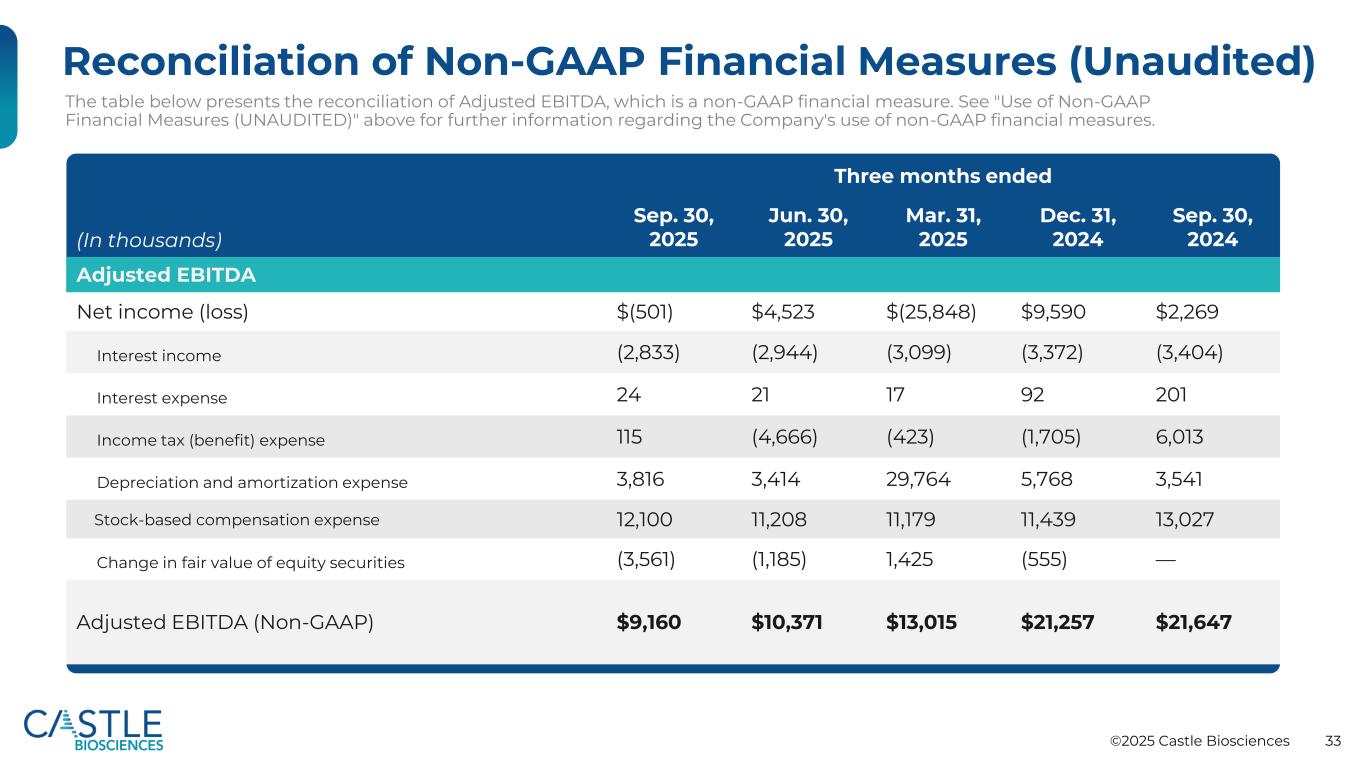
©2025 Castle Biosciences 33 Reconciliation of Non-GAAP Financial Measures (Unaudited) The table below presents the reconciliation of Adjusted EBITDA, which is a non-GAAP financial measure. See "Use of Non-GAAP Financial Measures (UNAUDITED)" above for further information regarding the Company's use of non-GAAP financial measures. (In thousands) Three months ended Sep. 30, 2025 Jun. 30, 2025 Mar. 31, 2025 Dec. 31, 2024 Sep. 30, 2024 Adjusted EBITDA Net income (loss) $(501) $4,523 $(25,848) $9,590 $2,269 Interest income (2,833) (2,944) (3,099) (3,372) (3,404) Interest expense 24 21 17 92 201 Income tax (benefit) expense 115 (4,666) (423) (1,705) 6,013 Depreciation and amortization expense 3,816 3,414 29,764 5,768 3,541 Stock-based compensation expense 12,100 11,208 11,179 11,439 13,027 Change in fair value of equity securities (3,561) (1,185) 1,425 (555) — Adjusted EBITDA (Non-GAAP) $9,160 $10,371 $13,015 $21,257 $21,647

©2025 Castle Biosciences 34 Thank You